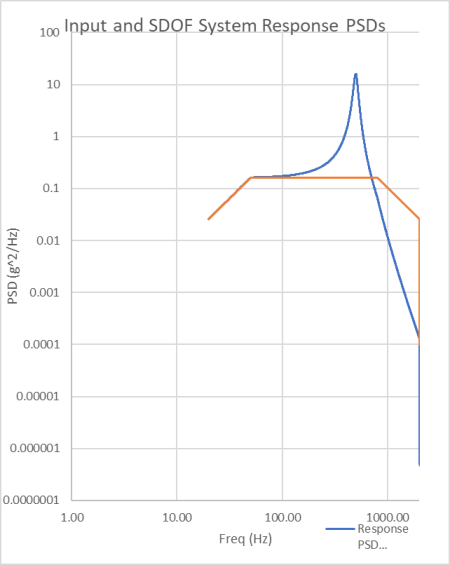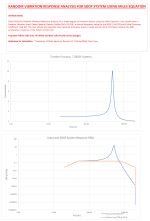Random Vibration Response analysis tool for SDOF systems

Description
Random Vibration Response Analysis tool, used to determine RMS response to Random Vibration Loads (PSD inputs). The tool employs the well-established Miles equation (detailed in 'Derivation of Miles Equation Revision D' 24/July/2008, Tom Irvine) and is useful for conservative preliminary sizing of structures subject to Random vibration type loading, as would be seen for spacecraft during rocket launch or aircraft components subject to structure borne noise from engines.
Random Vibration Response Analysis is a technique used to predict the RMS (Root Mean Square) response of a structure subjected to random vibration loads, such as those generated by a PSD (Power Spectral Density) input. The Miles equation is one of the commonly used methods to estimate the RMS response of a structure to a PSD input.
The steps involved in performing Random Vibration Response Analysis using the Miles equation are as follows:
-
Define the input PSD: The input PSD represents the random vibration loads acting on the structure. It is typically specified in terms of the acceleration spectral density (G^2/Hz), which gives the power per unit frequency range of the input signal.
-
Determine the transfer function of the structure: The transfer function of the structure relates the output response of the structure to the input PSD. It is a complex function that depends on the geometry, material properties, and boundary conditions of the structure.
-
Calculate the response PSD: The response PSD is the spectral density of the output response of the structure due to the input PSD. It can be obtained by multiplying the input PSD with the squared magnitude of the transfer function.
-
Calculate the RMS response: The RMS response of the structure is obtained by integrating the response PSD over all frequencies and taking the square root of the result.
The Miles equation is a simplified formula that provides an approximate estimate of the RMS response of a single-degree-of-freedom (SDOF) system to a random vibration load. The equation is given by:
RMS displacement = (S^2 * F) / (2 * π * m * w^4)
where S is the input acceleration PSD (in units of G^2/Hz), F is the system resonance force, m is the system mass, and w is the system natural frequency.
The Miles equation assumes that the system response is dominated by a single resonant frequency, and neglects the effects of damping and higher-order modes. It is often used as a quick and simple estimation tool for preliminary design and analysis, but more accurate methods, such as finite element analysis, should be used for detailed analysis and validation.
Calculation Preview
Full download access to any calculation is available to users with a paid or awarded subscription (XLC Pro).
Subscriptions are free to contributors to the site, alternatively they can be purchased.
Click here for information on subscriptions.



